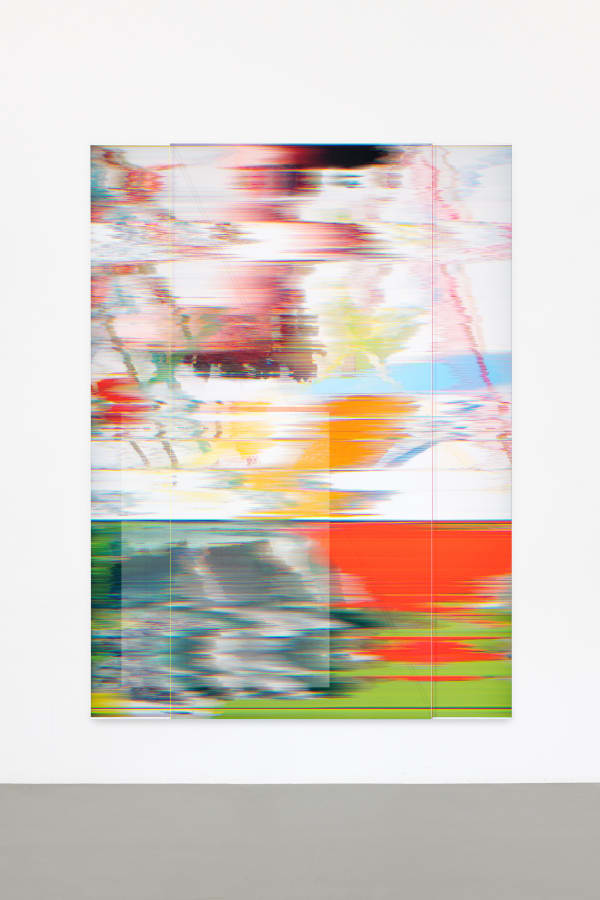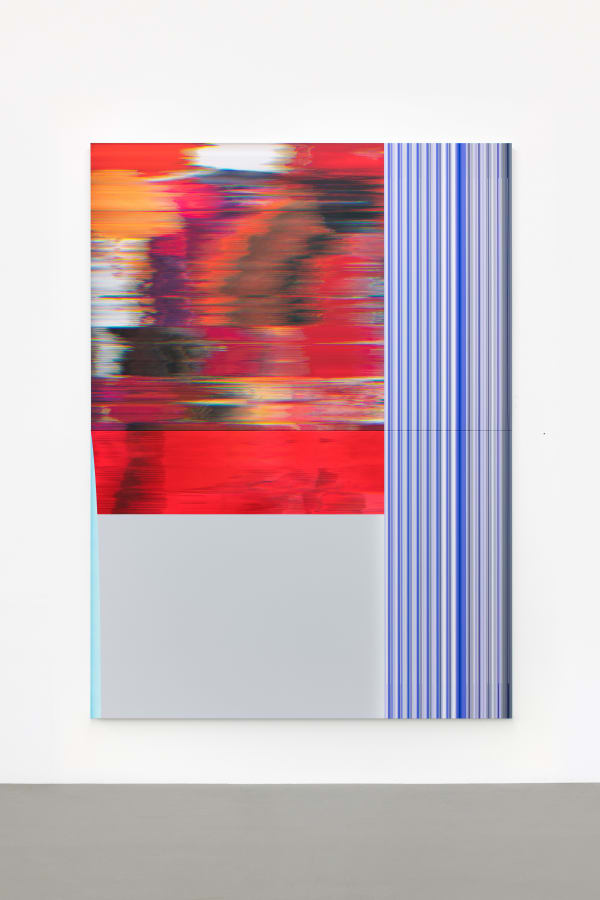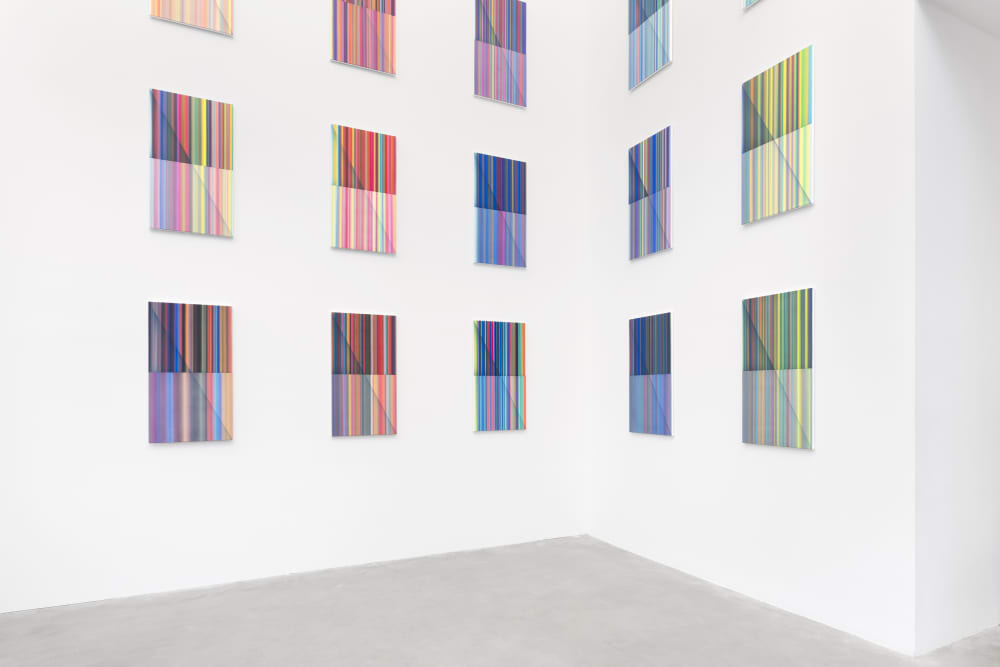Sekunde: Jonas Weichsel
-
Introduction
Galerie Thomas Schulte presents Sekunde, a solo exhibition featuring new works by Jonas Weichsel, in which he continues to bring analog and traditional painting techniques together with digital elements, building on his analytical painting practice of the past 15 years. In an elaborate new approach, color studies, watercolors, and print materials are transformed through collaging, scanning, and digital manipulation, and in turn subjected to further painting processes. The resulting paintings straddle the line between composition and its dissolution – not only tracing and renegotiating the process of an image’s creation, but also our perception of it.
In his ongoing engagement with questions of painting, his pursuit of the medium’s core, Weichsel carries out a meticulous and sensitive exploration of an essential element: color – which is mixed, cataloged, and set in complex arrangements. Often, from a distance, his images appear to be dominated by a particular color, or composed of consistent color fields; but, as we draw closer, the impression dissipates to reveal an unexpectedly wide array of constituent parts. In situating the medium in the digital age, he has at times used scanners and digital methods as part of an image’s production; or else as an aesthetic reference, for instance, with the brushstroke made to simulate smooth, mechanical motions. These systematic modes of encounter and shifts into highly detailed views together serve as an excavation of what an image can be: of the possibilities and limitations of painting today. Such lines of inquiry are carried through and interwoven in this new body of work, while given another dimension, as further compositional concerns are raised. In Sekunde, images continuously reformulate through an energetic field of relations – surface dynamics and material proximities that nonetheless make space for philosophical reflection.
Here, color has a particular openness, as well as a particular materiality. It is both more fragmentary and full of depth from the start, as collaged elements, including watercolors, act as a kind of source. Colors interact, disperse, are brought together in new arrangements, and undergo further alterations and layerings. There’s a collaging of prior materials, as well as processes – both measured and precise techniques developed by Weichsel, and more reactive movements and gestures. One stage of the painting process involves placing the collages on a scanner and manually moving them in changing directions, rhythms, and speeds that compound and contrast with the scanner’s own motion – an interplay of hand and “brush”. Dematerialized in this way, the resulting scans form the starting point for images that are made material again through a combination of printing, painted applications of color and physical interventions on canvas. Through a series of transformations and transferrences, there is a cyclical quality, a continual return.
Less pared down, linear or spectral than previous works, the paintings are largely suffused with an effect of melting color, which takes a distinctive formation in each image. Rough, patchy swaths bleed into one another; straight, decisive, ultra-fine lines cut through or stretch over. The relationships between colors are defined by jagged edges, at times more distinct and at others more visibly frayed, yet always remain fluid. Hints of geometric or schematic structures are sometimes visible, as though revealing the image’s inner workings, while opening up additional pictorial spaces like windows. Interactions of sharpness and blur, horizontal and vertical lines, suggest changing degrees of movement and depth. In this complex spatial environment, actual depth from superimpositions on the surface is complemented and reinforced by intangible traces embedded within. Gaps slip into overlays, closeness gives way to distance. Our own relationship to the image, as we try to find our way in, is prone to similar shifts. Depending on our vantage point, certain areas might come into or out of focus – small details come to the fore or recede to allow us to sink into the whole. Our perception continually readjusts, getting carried away and drifting back.
The wavy character of the works, whether found in the details or a more encompassing flow of movement, might recall a cardiogram, a polygraph, or sound frequencies – tracing and measuring rhythms and their changes. There’s also a suggestion of the magnified marks of a brush, its finely split hairs, weaving threads of many colors. Sometimes the full image takes shape as a strange, uncertain terrain, indiscernible as though viewed through textured glass. Or possibly a glitch – an image distorted on a screen, shredded into abstract color patterns. At any given moment, the question of which appearances of color are more directly related to manual, material means and which have been produced digitally or mechanically – of which is approximating, or responding to, which – remains open to debate. The intricacies of their overlaps prove difficult to disentangle.
Several instances of responsiveness contribute to bringing the images to form: different colors and media, hand and machine, respond to one another’s movements and conditions. It is a sense of immediacy that is retained throughout. The exhibition’s title, Sekunde, also speaks to this nature. It refers to a compositional interval, a measure of time that is broken down into small units. Precise in its divisions, yet abstract, elusive. What we might feel, think, or experience within a second is fuzzy, as one slips into the next. Yet, even if not necessarily experienced in isolation, each second carries its own weight. It’s through a meditative moment that we can, possibly, experience it more fully, bring it into focus. That we might be able to get absorbed into it – like the colors into their ground – allowing it to stretch out before us, even if only for a second longer.
Text by Julianne Cordray
-
Installation Views
-
Works
-
Inquire about works by Jonas Weichsel

-
Video
-
Artists on view











